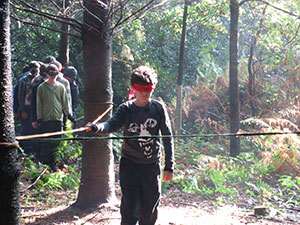
Marina Robb from Circle of Life Rediscovery outlines the importance of outdoor learning within the National park and how schools can access subsidised Forest Schools programmes through the rainbow Running project funded by the South Downs National Park Sustainable Communities Fund.
Words by Marina Robb:
There is no great difference between a stone-age body and a modern one. Movement and time spent outdoors improves health and well-being for both teachers and pupils. Developing young people’s motor skills, ability to co-ordinate and awareness of their own body is a natural part of outdoor learning.
As an outdoor practitioner and teacher since 1992, I agree wholeheartedly with the research that shows how teaching in the outdoors affords huge benefits young people. We know for example that it develops self-autonomy and confidence, a rich and varied spoken language and the ability to communicate with others and express thoughts.
The South Downs National Park Sustainable Communities Fund Grant awarded to Circle of Life Rediscovery CIC in summer 2013 for our ‘Running Rainbow Project’ has supported various outdoor learning opportunities for schools including Forest School, Outdoor learning Training for teachers and Outdoor Learning days out.
We have collated some information from our last Forest School at Ringmer Primary with the reception year that shows how self-esteem has increased in all 37 pupils who attending the Forest School.
The outdoor environment makes it possible for both pupils and teachers to show different sides of themselves. Surprisingly for some, everything is much easier outdoors! Pupils apply all their senses to learning and it’s easy to provide concrete examples and illustrate connections between topics.
Teachers report reduced noise levels, an increased understanding of topics, awakening an interest in nature, more exercise, and fun. This hands on approach, brings laughter and a life-long lust for learning.
We make every attempt to link school topics with the Forest School experience whilst listening to the children’s own eagerness, desire and curiosity in their learning.
We hope young people will acquire and be able see interconnections and discover new ways of understanding the surrounding world. I have chosen the following example as I hear snow is on the way.
Technology outdoors could introduce an activity known as ‘Snow to water’ where the purpose is to discover how the water quality differs depending on where you take the snow. Take 15 minutes to fetch snow and time for it to melt – use buckets. Then see what’s floating in the water. You can filter the snow using a coffee filter. Let the children hypothesis about how the water looks and why, and how it relates to where the snow was taken.
Or why not get ready for Spring and plan to make nature’s detergent! ‘Birch leaf detergent’: make your own detergent by collecting fresh birch leaves in a plastic bag. Add water, 100 to 200 ml. Shake the bag until white foam forms. Let the pupils wash their socks by putting them in the bag and shaking it a bit. The socks will smell nice once they are dried! You can discuss the impact of laundry and detergents. How is animal and plant life affected?
There are also endless ways of teaching mathematics and English in the outdoors too! We will be running two further outdoor learning training days, in June and September 2014 which will continue to inspire and equip teachers to get outdoors. Watch out also for our new publication which will have over 100 activities and games for teachers and families. 2014 promises to be an exciting year!
We are able to offer, through the ‘Running Rainbow Project’ two more subsidised 10 week forest school programmes and a number of outdoor learning days for schools.
If you are interested, please get in contact with Marina Robb:
Marina Robb (Msc; MA; PGCE)
Director
Circle of Life Rediscovery CIC
01273 814226
07966 514469
www.circleofliferediscovery.com
http://theoutdoorteacher.wordpress.com
www.facebook.com/circleofliferediscovery

